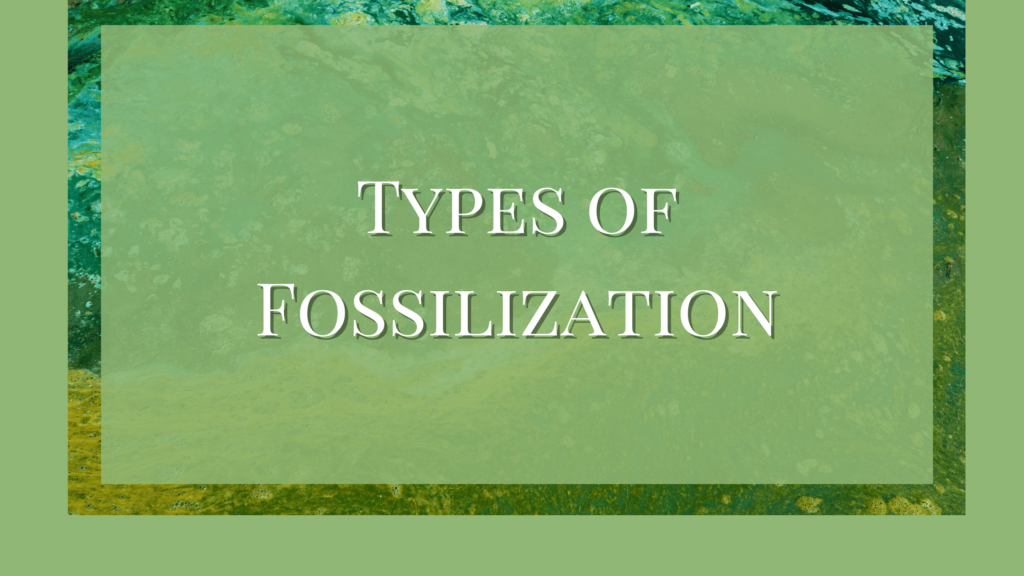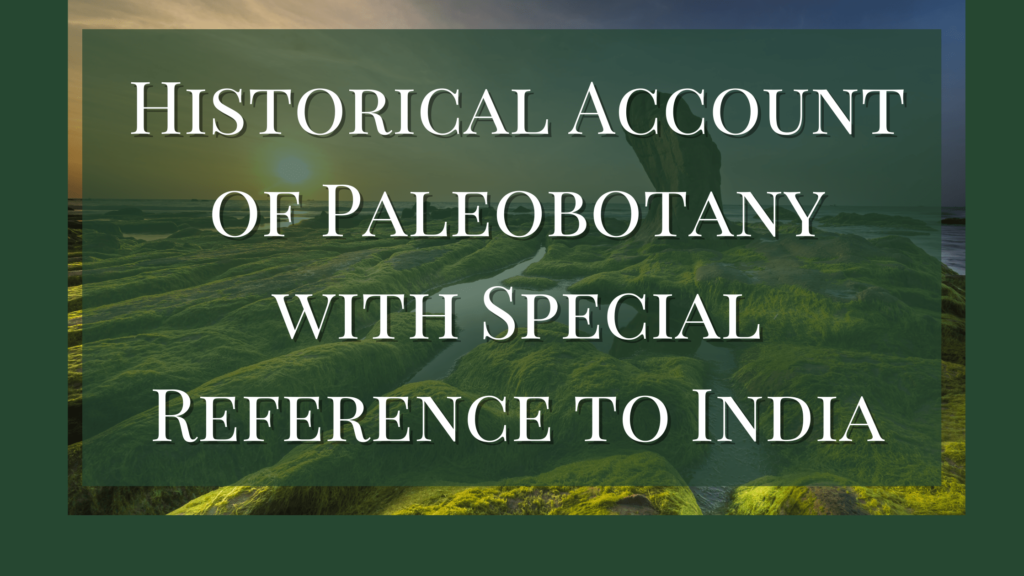Fossilization refers to the process of preservation of organic matter within the geological period. These fossils help study the plants and organisms in the ancient era or period.
For example, fossils found from Antarctica reveal that there used to be living organisms in this area. And that, they might have become extinct due to the gradual freezing of this area. Thus, the study of fossils and the understanding of the types of fossilization are both important.
Process and Types of Fossilization
While almost all living organisms may leave their fossils, only the hard parts of animals and plants are fossilized. The softer organic parts are gradually decayed and are rarely preserved. The harder parts such as bones, shells, spores, seeds, pollens, and other woody parts are often perfectly fossilized.
Under unfavorable or drastic weather conditions, the decay of the softer tissues is delayed, leading to their preservation. Lack of oxygen, high soil acidity, etc., are some such drastic conditions that favor fossilization. Sometimes the organic matter gets trapped inside amber or is frozen in a glacier. Depending on the plant parts and the prevailing weather conditions, there are different types of fossilization.
- The hard body of the plant part is usually covered by layers of sediments, over time. These parts are eventually replaced by mineral deposits.
- Dead plants can be preserved in amber, hardened tree resin, tar pits, ice, or peat bogs.
- Casts or impressions of larger plant parts could be formed by the gradual deposition of layers of sediments. They eventually become rock, thus preserving the casts.
Listed below are the various types of fossilization of plants.
Watch the Video
Impressions
An impression fossil is the most common form seen in sedimentary rocks such as shales, sandstones, limestones, etc. As the name indicates, these fossils represent just an imprint of the original plant part. The original organic matter has been destroyed.
Impression fossils are found on sedimentary rocks, along their bedding planes. When a plant part fell near a site of sedimentation or was transported to the site of sedimentation, it was immediately covered by a layer of unconsolidated sediment or mud. This covering of the plant part by a sedimentary layer protects it to some extent.
However, before the consolidation of the sedimentary layer could take place, the plant part underwent compression due to the overlying sediments. Fungal and bacterial activities were set in and the organic matter of the plant part was destroyed.
Later, due to water evaporation, consolidation of the sedimentary layer took place which left the imprint of the plant part. Thus the formation of an impression fossil occurs concomitantly with the process of sedimentation and formation of sedimentary rocks.
Leaves are the most common plant organs to be preserved as impressions. Impression specimens of other plant organs such as roots, stems, and fructifications have also been found.
The most common examples of impressions are the leaves of Glossopteris and Gangamopteris found in various colored shales of the lower Gondwana Strata (Permian). Impression specimens are studied by making superficial observations under a low-power microscope.
Compressions
This is the second most common type of plant preservation. When a plant part falls at the site of sedimentation it is immediately covered by a fine-grained sedimentary layer. It leaves no opportunity for fungal or bacterial actions on the plant material. This will lead to immediate compression due to the overlying sediments.
During this process, water and other gasses from the plant tissues are released and the plant material is flattened. The compression specimens are well preserved in shales and clay.
Certain microscopic algae such as diatoms give rise to a sedimentary rock which is formed exclusively by compression of the siliceous diatom frustules or shells. Such rocks are called diatomites.
Petrification
This is one of the most common types of fossilization and is valuable for Paleobotany, as it gives considerable information. The term petrifactions is derived from the Latin word ‘petros’ which means rock. Accordingly, petrified plant material resembles a rock.
The process of petrifaction is complex and is not fully understood by either paleobotanists or geologists. However, it is certain that during this process, the plant material becomes impregnated by minerals in the form of a solution which will later consolidate and precipitate to form a solid stone-like structure. Thus it could be said that petrification is a process that turns organic materials into rock.
In this process, the inorganic minerals such as silica or calcium carbonate slowly enter the tissues and replace the organic matter and the cellular structure. A chemical analysis shows that petrification consists of 20 different minerals that infilter the plant materials. Yet, silicates like silicon dioxides and carbonates like calcium or magnesium carbonates are the most commonly found minerals.
Unlike impression and compression, petrifaction leaves the original organic matter of the plant more or less intact. Even the size and shape of the plant part are well preserved here without undergoing much alterations. Hence, in addition to the internal structure of the plants, petrifaction also gives a three-dimensional idea of the original plant material.
A critical survey of the anatomical studies of the plant material from petrifaction showed that most of the information was gathered from silicified and calcified petrifactions. These two types of petrifactions indicate the petrifying mineral to be silica in the former and calcium or magnesium carbonate in the latter.
Almost all the petrifaction discovered from various geologic strata of India is silicified. Contrarily, most of the petrification unearthed from fossil localities in the USA, England and continental Europe are calcified in nature. It should also be noted that this process could take more than a few years to millions of years to take place. Wood is one of the most common types to become petrified.
Coal Balls
Most of the paleobotanical work dealing with petrified plant materials in the USA and the UK was based on investigations done on the calcified petrifactions. These are variously shaped nodules preserved in close association with coal seams and are called coal balls. Since some of the earlier petrifactions of this type collected from England were spherical, they were called coal balls.
Features of Coal Balls
- Coal balls have a sub-spherical shape with an irregular outline.
- They are composed of minerals such as magnesium and calcium carbonates.
- Their size varies from a few millimeters to one meter in diameter.
- They can weigh anywhere from 20 gm to 3000 kg.
- They may occur only in particular regions as scattered pockets or definite bands.
Coal balls usually contain delicate plant organs unfiltered with minerals that prevent the plant organs from becoming coal. Instead, they become coal balls.
Types of Coal Balls
Mamay and Yochelson (1962) studied coal balls from coal seams in Kansal, Oklahoma, Iowa, and Illinois, and recognized the following three types.
- Normal coal balls containing only plants
- Mixed coal balls containing both plants and native animals.
- Faunal coal balls contain only animals.
A section of a coal ball using a diamond saw reveals aggregation of different plant parts such as leaves, stems, roots, rhizomes, fructifications, and vascular tissues of various types of different orientations.
Paper coals are limestone deposits in leaves and are also called leaf coal. They are very thin as paper and thus the name. The leaves preserve their epidermis and cuticle. They are found in Toula, Russia.
Mold
As the name indicates, a mold has the overall form of the original plant material. However, its organic matter is not preserved in these types of fossilization. Usually, three-dimensional plant parts such as stems with external markings, seeds, fruits, etc are ideal for such preservation.
When these plant parts are carried to the site of sedimentation, they are buried in the sediments and coated with sedimentary layers. These layers will quickly harden, preventing the crushing of the inner plant parts. Eventually, the plant parts disintegrate and leave a cavity on the rocks, which is the mold.
Several isolated seeds and oogonia or Chara are known to be preserved in such molds. These molds give us an idea of the three-dimensional pattern, size, shape, and external features of the original plant parts.
Cast
A cast represents the opposite of a mold. This type of fossil was formed by the filling up of naturally occurring cavities such as the pith cavities with the sedimentary material. Similar to the mold, the cast contains no organic matter from the original plant material. It reveals only the size, shape, and internal contours of the original plant material, in a three-dimensional pattern.
Some classical examples of casts are the pith casts of Calamites and Stigmanian root casts, so beautifully preserved in Victoria Park in Glasgow. These Stigmanian root cats with a rootstock measuring 2-3 feet in diameter and the roots branching and spreading up to a length of 10 feet were discovered during quarrying operations. It was protected by erecting a roof over them.
Amber
Some types of fossilization mummify the plant parts or other organisms in them. This is a type of mummification where insects or plant parts are entombed in fossilized resin derived from various angiosperms or gymnosperm trees.
Amber is thus a fossilized golden yellow resin that has undergone certain chemical changes. As the resin oozed copiously from the trees, it entrapped the plant parts such as leaves, twigs, flowers, and sometimes complete insects or their parts in its gluey path.
Given their oddity and beautiful transparent nature, fossilized insects and plant parts preserved in amber are prized for jewelry. Thus they are in great demand despite being very costly due to the rarity of its formation.
Amber is seen in different types of rocks from the Carboniferous period to the Pleistocene. Later, tertiary deposits in the Baltic region of the Soviet Union are known to be the world’s richest area for amber deposits.
Nodules
Nodules are water-transported sedimentary formations with a rounded and smooth surface. The plant material in this type of fossilization is preserved either in the form of an impression or compression. However, the preserved plant material can be seen only when the nodules are split open in the middle.
The plant part in this case acted as a nucleus around which deposition of very fine-grained sediments took place. These rocks with reserved plant materials are carried through rivers and streams. Eg. Sphenophyllum leaf.
Coprolites
These are the fossilized feces or excreta of animals. The excreta or droppings of animals were immediately covered by fine-grained sedimentary material. Thus decay was precluded.
A careful analysis of these coprolites has revealed the presence of a large number of microorganisms such as diatoms and desmids as well as undigested plant parts such as leaf cuticles and vascular elements.
Coprolites of the dinosaurs have been described from the Jurassic strata of various countries, including the central part of India.
Pseudofossils
In nature, apart from the true fossils, there also are pseudofossils which resemble plant fossils at first glance. However, close examination reveals that their structure is unlike that of plants.
Usually, dark-colored minerals enter the rock crevices in solution. These minerals get crystallized and consolidated in the shape of plant parts. Such pseudofossils are referred to as Dendrites.
References
- Fossils | Earth Science. (n.d.). https://courses.lumenlearning.com/suny-earthscience/chapter/fossils/
- L. (2023, October 31). 18.5B: Fossil Formation. Biology LibreTexts.
Additional Reading
- Introduction to Paleobotany
- History of Paleobotany
- Contribution of Birbal Sahni and Others
- Methods of Studying Microfossils in a Laboratory




